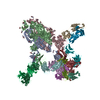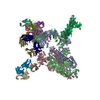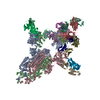+Search query
-Structure paper
| Title | Dosing interval regimen shapes potency and breadth of antibody repertoire after vaccination of SARS-CoV-2 RBD protein subunit vaccine. |
|---|---|
| Journal, issue, pages | Cell Discov, Vol. 9, Issue 1, Page 79, Year 2023 |
| Publish date | Jul 28, 2023 |
 Authors Authors | Shuxin Guo / Yuxuan Zheng / Zhengrong Gao / Minrun Duan / Sheng Liu / Pan Du / XiaoYu Xu / Kun Xu / Xin Zhao / Yan Chai / Peiyi Wang / Qi Zhao / George F Gao / Lianpan Dai /  |
| PubMed Abstract | Vaccination with different vaccines has been implemented globally to counter the continuous COVID-19 pandemic. However, the vaccine-elicited antibodies have reduced efficiency against the highly ...Vaccination with different vaccines has been implemented globally to counter the continuous COVID-19 pandemic. However, the vaccine-elicited antibodies have reduced efficiency against the highly mutated Omicron sub-variants. Previously, we developed a protein subunit COVID-19 vaccine called ZF2001, based on the dimeric receptor-binding domain (RBD). This vaccine has been administered using different dosing intervals in real-world setting. Some individuals received three doses of ZF2001, with a one-month interval between each dose, due to urgent clinical requirements. Others had an extended dosing interval of up to five months between the second and third dose, a standard vaccination regimen for the protein subunit vaccine against hepatitis B. In this study, we profile B cell responses in individuals who received three doses of ZF2001, and compared those with long or short dosing intervals. We observed that the long-interval group exhibited higher and broader serologic antibody responses. These responses were associated with the increased size and evolution of vaccine-elicited B-cell receptor repertoires, characterized by the elevation of expanded clonotypes and somatic hypermutations. Both groups of individuals generated substantial amounts of broadly neutralizing antibodies (bnAbs) against various SARS-CoV-2 variants, including Omicron sub-variants such as XBB. These bnAbs target four antigenic sites within the RBD. To determine the vulnerable site of SARS-CoV-2, we employed cryo-electron microscopy to identify the epitopes of highly potent bnAbs that targeted two major sites. Our findings provide immunological insights into the B cell responses elicited by RBD-based vaccine, and suggest that a vaccination regimen of prolonging time interval should be used in practice. |
 External links External links |  Cell Discov / Cell Discov /  PubMed:37507370 / PubMed:37507370 /  PubMed Central PubMed Central |
| Methods | EM (single particle) |
| Resolution | 2.34 - 2.85 Å |
| Structure data | EMDB-34928, PDB-8hp9: EMDB-34931, PDB-8hpf: EMDB-34940, PDB-8hpq: EMDB-34944, PDB-8hpu: EMDB-34945, PDB-8hpv: EMDB-34946, PDB-8hq7: |
| Chemicals |  ChemComp-NAG: |
| Source |
|
 Keywords Keywords |  IMMUNE SYSTEM/VIRAL PROTEIN / IMMUNE SYSTEM/VIRAL PROTEIN /  SARS-CoV-2 / Omicron BA.2 S-trimer / Cryo-EM structure / SARS-CoV-2 / Omicron BA.2 S-trimer / Cryo-EM structure /  fab / fab /  IMMUNE SYSTEM-VIRAL PROTEIN complex / Omicron BA.2 RBD / Omicron BA.4 S-trimer / Omicron BA.4 RBD / Omicron Prototype S-trimer / Omicron Prototype RBD IMMUNE SYSTEM-VIRAL PROTEIN complex / Omicron BA.2 RBD / Omicron BA.4 S-trimer / Omicron BA.4 RBD / Omicron Prototype S-trimer / Omicron Prototype RBD |
 Movie
Movie Controller
Controller Structure viewers
Structure viewers About Yorodumi Papers
About Yorodumi Papers

















